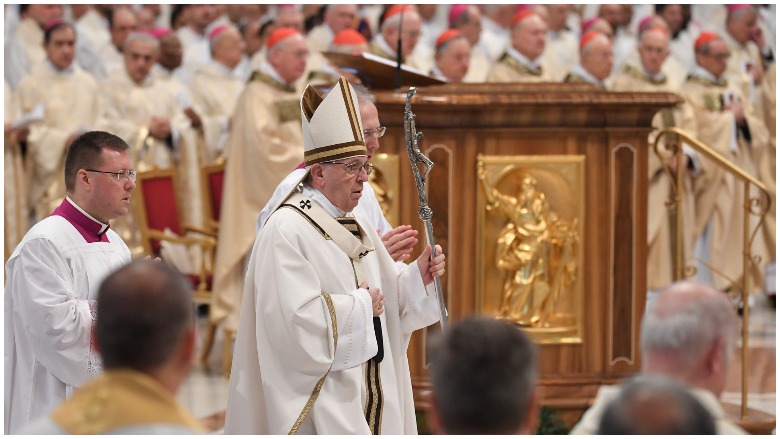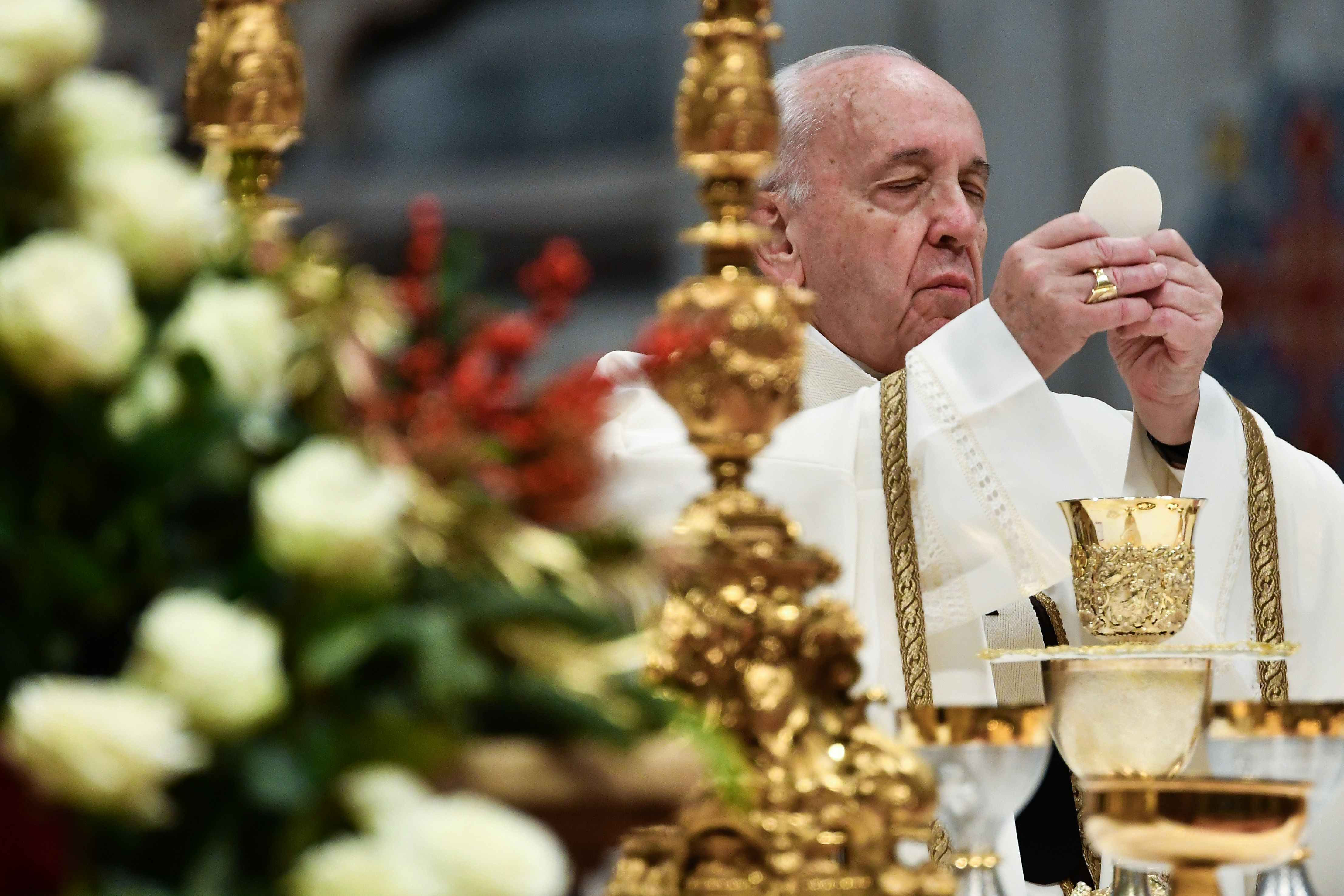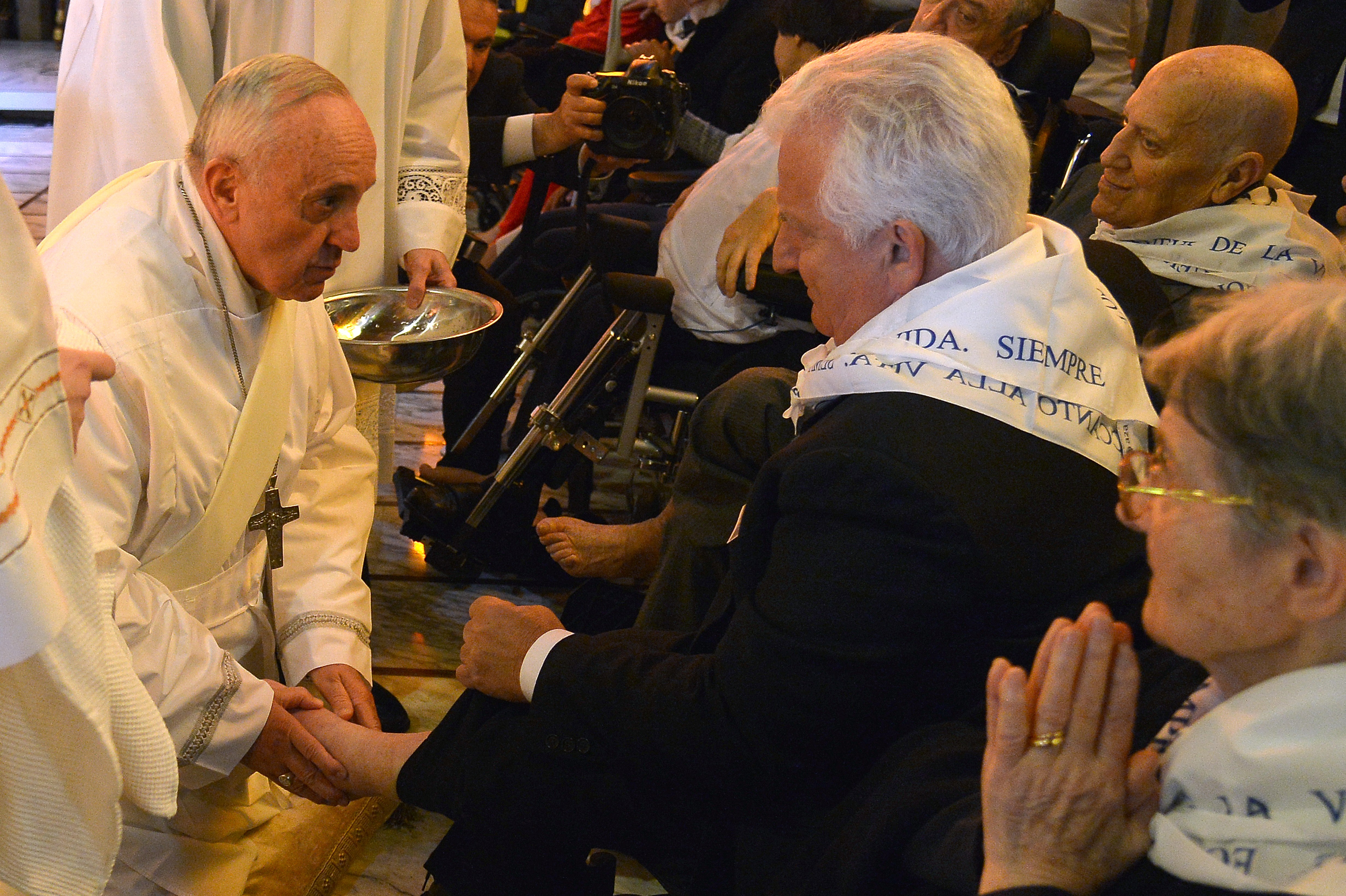
Catholics and other Christians have been marking Holy Week in the lead-up to the Easter celebration. Today is Maundy Thursday, or Holy Thursday, as most Catholic congregations in the United States refer to it.
Holy Thursday commemorates the Last Supper and the Washing of the Feet. The Bible explains that during this Passover feast, Jesus also revealed that one of the apostles would betray him.
This is typically the day practicing Catholics end their Lenten sacrifices, Bishop Robert J. Brennan of the Diocese of Columbus in Ohio explained to Heavy. Holy Thursday marks the transition from Lent into the Triduum or three days of Christ’s Passion.
Here’s what you need to know:
Catholics Celebrate the Last Supper at Every Mass Through the Eucharist

Getty Pope Francis holds the sacramental bread as he celebrates the Eucharist during the Epiphany mass on January 6, 2020 at St. Peter’s Basilica in the Vatican.
Before his arrest and crucifixion, Jesus was in Jerusalem to celebrate Passover with his friends and family. Catholics believe that during this feast, Jesus took bread and wine and offered them up as his body and blood.
As Bishop Robert J. Brennan of the Diocese of Columbus in Ohio explained to Heavy, “It was at the Last Supper, while taking bread and wine and changing it into His Body and Blood, that Christ commanded the apostles, ‘Do this in memory of me.’ Catholics believe the Last Supper is the first Mass and at every Mass we fulfill Christ’s commandment.” This sacrament is called the Eucharist, or the Holy Communion.
The bishop added that while the Eucharist is celebrated at each mass, it holds special weight on Holy Thursday. “Holy Thursday is a special day to remember the gift of the Mass and Christ’s real presence in the Eucharist.”
The story of the Last Supper is detailed in Corinthians in the Bible. The U.S. Conference of Catholic Bishops has this version on its website:
Brothers and sisters:
I received from the Lord what I also handed on to you,
that the Lord Jesus, on the night he was handed over,
took bread, and, after he had given thanks,
broke it and said, “This is my body that is for you.
Do this in remembrance of me.”
In the same way also the cup, after supper, saying,
“This cup is the new covenant in my blood.
Do this, as often as you drink it, in remembrance of me.”
For as often as you eat this bread and drink the cup,
you proclaim the death of the Lord until he comes.
Various Christian denominations differ on how to interpret this Bible story. The Catholic faith teaches transubstantiation, meaning that the bread and wine actually become the body and blood of Jesus. However, a Pew Research survey from 2019 found that only about one-third of American Catholics actually believe this. Nearly 70% of those surveyed said they viewed the bread and wine as symbols of Jesus’ body and blood.
‘Maundy’ Comes From the Latin Word for Command & Refers to Jesus’ Commandment to Love & Serve Others, Which He Demonstrated With the Washing of the Feet

GettyPope Francis performs the traditional Washing of the Feet during a visit at a center for disabled people on Holy Thursday (Maundy Thursday) on April 17, 2014 in Rome.
Holy Thursday is also known as Maundy Thursday. “Maundy” comes from the Latin word “mandatum,” which means “commandment.” Bishop Brennan explained to Heavy that this “refers to the command to love and serve, which Christ gives to the apostles at the Last Supper.”
Jesus provided a physical example for serving others when he washed the feet of his disciples during the Last Supper. The Gospel reading that Catholics will hear at mass today reads in part:
He came to Simon Peter, who said to him,
“Master, are you going to wash my feet?”
Jesus answered and said to him,
“What I am doing, you do not understand now,
but you will understand later.”
Peter said to him, “You will never wash my feet.”
Jesus answered him,
“Unless I wash you, you will have no inheritance with me.”
Simon Peter said to him,
“Master, then not only my feet, but my hands and head as well.”
Jesus said to him,
“Whoever has bathed has no need except to have his feet washed,
for he is clean all over;
so you are clean, but not all.”
For he knew who would betray him;
for this reason, he said, “Not all of you are clean.”So when he had washed their feet
and put his garments back on and reclined at table again,
he said to them, “Do you realize what I have done for you?
You call me ‘teacher’ and ‘master,’ and rightly so, for indeed I am.
If I, therefore, the master and teacher, have washed your feet,
you ought to wash one another’s feet.
I have given you a model to follow,
so that as I have done for you, you should also do.”
Catholic priests honor this tradition by washing the feet of a group of parishioners during the Holy Thursday mass. Pope Francis has typically followed this tradition. In 2019, he washed the feet of 12 inmates at a prison near Rome during the Mass of the Lord’s Supper, the Vatican reported.
READ NEXT: What Happened on Palm Sunday & What Do the Palms Represent?